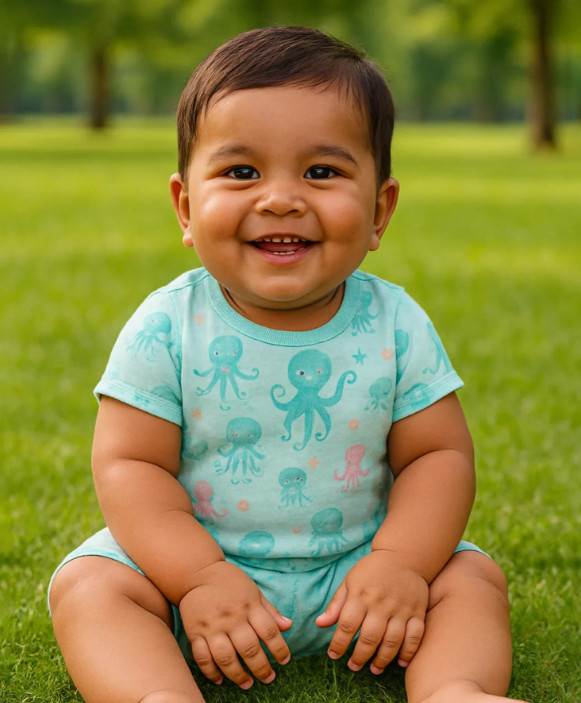views
Scroll through any parenting forum today and you’ll spot the same question on repeat: “Which baby romper is really worth buying?” India’s baby clothes segment is booming, forecast to top ₹51,600 crore (US $6.2 billion) in 2025 and still climbing 📈 statista.com. With so much choice, new parents need a checklist that cuts marketing noise and zeroes in on comfort, safety and sustainability. Below you’ll find evidence‑backed guidance, a quick‑scan buying list and reader‑friendly tips to keep every tiny outfit looking (and feeling) brand‑new.

Why Baby Rompers Remain a Parent Favourite in 2025
One‑piece convenience
Changing a wiggly newborn at 3 a.m. is easier when top and bottom are stitched together. Rompers skip the ride‑up problem of two‑piece sets and keep delicate tummies covered even during tummy time.
Skin protection in a tropical climate
Newborn skin is about 30 % thinner than adult skin and loses water faster, so friction and trapped heat matter more. Smooth, breathable fabrics—especially organic cotton—lower the chance of redness and eczema flare‑ups, according to dermatology reviews of infant skin‑care products pubmed.ncbi.nlm.nih.gov.
Smart sizing
Expandable shoulder flaps and gusset snaps mean one romper size can last several weeks—handy when you’re stocking up on Baby boy clothes 0‑12 months before a growth spurt.
Market shift toward eco options
Indian demand for rompers made with organic or recycled fibres is growing at 5.7 % CAGR through 2031 as conscious parents look for planet‑friendly choices kbvresearch.com.
Five Features to Check Before You Buy
1. Fabric & Skin Safety
-
Choose GOTS‑certified organic cotton for everyday wear. It’s grown without pesticide residues and widely recommended for babies prone to eczema.
-
Check dye safety. Look for OEKO‑TEX® Standard 100 labels to avoid azo dyes and heavy metals.
-
Watch out for nickel. Snap fasteners should be nickel‑free—nickel allergy is one of the top paediatric contact allergens.
Pro Tip: If your baby has persistent flare‑ups, run a quick patch test on the inside upper arm when introducing any new fabric.
2. Fit & Fastenings
-
Rompers should be snug but not tight to avoid bunching under the chin, a safety point echoed in the American Academy of Pediatrics’ safe‑sleep guidance. Soft, flat seams and no loose strings minimize irritation and choking hazards. aap.org
-
Two‑way zips let you change diapers from the bottom without exposing the chest to cool air—brilliant for night‑time changes.
3. Climate‑Ready Breathability
India’s summer temperatures can hit 45 °C, so fabric weight matters. Look for cotton under 180 gsm and mesh inserts under the arms or along side panels for ventilation. Bamboo‑viscose blends also wick moisture quickly but should still pass OEKO‑TEX® testing.
4. Room to Grow
Buy one size up if you plan to layer cloth nappies. Check that shoulder flaps or snap‑down panels extend rise length; you’ll get two to three extra weeks of wear.
5. Sustainability Credentials
Parents increasingly ask about end‑of‑life plans for clothing. Brands that offer repair kits, take‑back recycling or mono‑material construction (100 % cotton threads and labels) make it easier to recycle or compost textiles later.
Top Romper Styles Dominating Indian Wardrobes in 2025
| Style | Best For | Why Parents Love It |
|---|---|---|
| Kimono‑wrap romper | Newborn stage | Side‑tie avoids pulling garments over tender heads |
| Sleeveless playsuit | Peak summer | Maximum airflow; pairs with sun‑safe hat |
| Footed zip‑up | Night sleep | Covers toes without loose socks; works with room AC |
| Reversible print romper | Gift‑giving | Two looks, half the laundry; sustainable print dyes |
| Smart sensor romper | Preemies/medical needs | Monitors temperature and alerts phone if baby overheats |
Care Tips That Extend Romper Life
-
Pre‑wash new clothes in a mild, fragrance‑free detergent.
-
Skip fabric softener—it coats fibres and reduces absorbency.
-
Line‑dry inside out in shade to protect plant‑based dyes.
-
Inspect snaps weekly; replace any loose fasteners immediately to prevent choking.
Quick Q&A
Q1: How many rompers does a newborn really need?
A: Aim for 7–10 pieces so you can do laundry every two or three days without stress.
Q2: Are smart‑textile rompers safe?
A: Choose products with removable sensors and CE or BIS safety marks; follow the manufacturer’s washing instructions to preserve circuitry.
Q3: Can I use the same romper year‑round?
A: Yes—layer with a light vest in winter and use it alone in summer. The WHO emphasizes dressing babies in breathable layers to avoid overheating during naps. who.int
Conclusion – Build a Romper Line‑Up That Works Harder
Choosing the right baby romper is less about trending prints and more about thoughtful fabric, safe fastenings and adaptability for India’s varied climate. Stick to organic cotton where possible, verify safety certifications and think beyond single‑season wear. Your baby—and the planet—will thank you.
Which feature tops your priority list: fabric, fit or future‑proof sizing? Share your answer in the comments and help other new parents shop smarter!



Comments
0 comment